We may earn revenue from the products available on this page and participate in affiliate programs. Learn more ›

Deciding to play drums has some caveats: they’re bulky, heavy, and very loud—but then there are e-drums. With electronic drums, beginners can play at home without driving everyone within earshot crazy, although they should still shut the door, as no e-drum is a completely silent drum kit. They are, however, easier to set up in smaller spaces than their acoustic counterparts. Each one allows beginners to play a selection of different-sounding drum kits from headphones from the comfort of home. Many include dedicated exercises for improving your skills, and some cost less than a single high-end crash cymbal. And when it’s time to move things around, an electronic drum kit can assuage weight and size problems. E-drums may not change the fact that nine out of 10 people will have no idea who the drummer is when a show is over, but these drum sets will help ensure your back, unlike your ego, isn’t bruised. On the plus side, good drummers are always wanted, and a selection from our hand-picked list of the best electronic drum sets for beginners can help you become one. Happy hitting.
- Best overall: Roland TD-1DMK
- Best portable: Yamaha DD-75
- Best big kit: Alesis Nitro Mesh Expansion Kit Bundle
- Best compact: Roland TD-02KV
- Best budget: Alesis Turbo Mesh
- Also consider: Kat KT-150
How we chose the best electronic drum sets for beginners
As a drummer of many years with a history of owning and playing a variety of electronic drum kits from different brands, I have experience with either the products on this list or with related e-drum kits of the same line. I know first-hand that brand reputations are often based in truth but also are not everything. Because this guide focuses on beginners, there are particular concerns I considered, such as the ease of operation and setup for someone who has never used an electronic drum module or set up a kit before; the availability of beginner-friendly features, such as built-in lessons and other features that can aid learning; and, because beginners are often young and may not have an excess of budget and square footage, both the price and the size of the kits.
The best electronic drum sets for beginners: Reviews & Recommendations
In some cases, electronic drum sets for beginners may not differ too much from the overall best electronic drum sets. Realistically, however, electronic drumming beginners rarely start with the best of the best that the market has to offer, and that’s perfectly fine. These beginner-oriented kits still offer a great feel from their drum and cymbal pads, a diverse variety of drum and percussion sounds from their modules, and more often than not, include much-needed learning modes that provide some technological help to supplement a beginning drummer’s lessons. The variety of e-drum sets here represents different needs for kit size, budget, and extra features.
Best overall: Roland TD-1DMK
Roland TD-1DMK
Best overall
Why it made the cut: While the sound module is easy to use and has practice features for beginners, the mesh-head pads are as good as they come in an entry-level kit.
Specs
- Kit Configuration: 1 x mounted kick pad (kick pedal not included); 1 x PDX-8 8-inch mesh dual-trigger snare drum; 3 x PDX-6A 6-inch mesh toms; 3 x CY-5 10-inch dual-trigger cymbal pads
- Number of Sounds: 15 kits
- I/O: 1 x 1/8-inch aux input; 1 x 1/8-inch stereo output; 1 x USB Type-B
Pros
- All mesh-head drum pads, including dual-zone snare
- Roland V-Drum sounds are some of the best in the business
- Many practice features in the module and included software
- Mesh heads are “tunable” for finding the right resistance
Cons
- Kick pedal not included
- Cymbal pads don’t have “choking”
- Toms are not dual-zone
For beginners convinced they’re ready to start with some of the best electronic drum sounds and drum pads around, the Roland V-Drums TD-1DMK set provides some luscious-sounding drums and the very responsive and “tunable” mesh head pads that have helped establish V-Drums as the top of the e-drum food chain.
This kit’s basic TD-1 sound module helps keep the price low with its very simple controls, making it easy to use. However, its 15 preset drum kits inside still have all the hallmark quality of Roland V-Drums’s detailed and expressive sound, and they range in style from acoustic-sounding rock kits to electronic dance kits. The module also has built-in practice tools, including 15 songs and a metronome to jam along to, and 10 onboard Coach functions to play along to a beat, changing rhythms, changing tempos, steady tempos, and other exercises for developing timing, as well as drum-stick velocity control. You can also plug into the 1/8-inch aux input to play along to songs of your choice. To go even deeper into your study, the kit includes Melodics for V-Drums computer software, which you connect to over the TD-1’s USB port. Melodics has drummers of all skill levels play along to beats and commercially-released songs to improve their abilities with detailed feedback on their performances to gamify practice and improve results.
All three of the TD-1DMK kits’ cymbal pads have dual triggers; they can trigger separate sounds from both the bow and the edge of the cymbal pad. Also, unlike some very rigid cymbal pads in e-drum kits, they swing and sway like proper acoustic cymbals. The kick drum pad is mounted to a pole of the TD-1DMK rack stand system and is large enough to work with a double kick pedal. However, no kick pedal is included with this kit. But considering how astronomical the prices of high-end V-Drum kits can get, the TD-1DMK’s cost of about $550 is rather reasonable to give a beginner a taste of the best sounds and mesh drum heads Roland has to offer.
Best portable: Yamaha DD-75
Best portable
Yamaha DD-75
Why it made the cut: With eight drum pads, two pedals, and hundreds of great sounds, this mimics the layout of a full drum kit in a 10-pound portable package, and you can even play it like hand percussion.
Specs
- Kit Configuration: 8 x touch-sensitive drum pads; 2 x drum trigger pedals; 3 x PDX-6A 6-inch mesh toms; 1 x CY-5 10-inch hi-hat pad; 1 x C-5 10-inch dual-trigger crash pad; 1 x CY-5 10-inch dual-trigger ride pad
- Number of Sounds: 75 kits, 570 instruments
- I/O: 1 x 1/8-inch aux input; 1 x 1/4-inch TRS output; 2 x 1/4-inch pedal inputs; 1 x 5-pin MIDI In; 1 x 5-pin MIDI Out
Pros
- Can play with both sticks and hands
- Tons of internal sounds bequeathed from pro Yamaha gear
- Battery power option and built-in speakers for portability
- Includes two portable foot pedals
Cons
- No USB connectivity
- No internal learning modes other than play-along songs
Many beginners may be short on available cash and space to accommodate a full set of electronic drums. Yet with the Yamaha DD-75, they can enjoy an entire e-drum setup in a module weighing just 10 pounds. It’s particularly handy for kids and young adults who want to take it to a friend’s house to jam. The units include eight drums pads arranged like a typical drum kit with pads for snare, three toms, hi-hat, ride cymbal, and two crash cymbals. It also adds two small push-pedals for the kick drum and hi-hat control. While it includes an AC power supply, battery power is also an option, and along with the built-in speakers, the DD-75 is truly a portable powerhouse. An audio output lets you plug-in headphones or powered speakers.
The DD-75 comes loaded with hundreds of drum sounds handed down from Yamaha’s professional DTX-series of e-drums and modules, including a diverse selection of acoustic and electronic sounds representing classic drum machine sounds, rock, Latin pop, jazz, world beat, and many other styles. In a unique twist you won’t find with other electronic drum sets in this guide, you can also play the DD-75’s pads with your hands, and the module has many hand percussion kits that make use of Middle Eastern, Chinese, Indian, and many other sounds. It has 105 built-in songs to play along to, or you can plug in an external audio source to rock out to the music of your choice. Even if you do graduate to a larger kit, the $300 DD-75 can always have a place in your studio as an add-on sound source.
Best big kit: Alesis Nitro Mesh Expansion Kit Bundle
Best big kit
Alesis Nitro Mesh Expansion Kit Bundle
Why it made the cut: This bundle complements its five total drum pads and four total cymbals with a highly featured drum module full of editable kits and sounds—all at a value price.
Specs
- Kit Configuration: 1 x kick pad tower w/kick pedal; 1 x 8-inch mesh dual-zone snare pad; 4 x 8-inch tom pads; 2 x 10-inch crash cymbal pads w/choking; 1 x 10-inch ride cymbal pad; 1 x 10-inch hi-hat pads w/foot controller
- Number of Sounds: 40 kits, 385 instruments
- I/O: 1 x 1/8-inch aux input; 2 x 1/4-inch outputs; 1 x 1/8-inch headphone output; 1 x 5-pin MIDI In; 1 x 5-pin MIDI Out; 1 x USB Type-B
Pros
- Five drum pads, all with mesh heads
- A lot of variety and quantity of drum sounds
- Editable drum kits and sounds
- Tunable mesh heads and chokable crash cymbals
Cons
- Rack stand not as sturdy as some of the competition
- No built-in practice exercises
Having more drums and cymbals won’t make you a better drummer, but it can be more fun. Purchasing the Alesis Nitro Mesh Expansion Kit Bundle puts an extra cymbal and drum pad at your disposal for the same price as competing kits (about $550). All the drum pads have quiet mesh heads—“tunable” to set their resistance—and the two crash cymbals have “choking,” which means you can quiet them by grabbing them like an acoustic cymbal. The snare is also dual-zone so that it will play, for example, both rim shots on its edge and the full snare sound from the mesh head.
The accompanying Nitro drum module comes bursting with 40 drum kits comprising acoustic-style kits, percussion kits, and electronic kits. The kits and the 385 individual sounds are editable, so you can experiment with the extra pads by assigning them whatever sounds you like and saving your own kits. The module also has 60 play-along songs built in and an aux input for plugging in and jamming along to your own tunes. A performance recorder even lets you record and listen back to your playing. If you want to connect to and play virtual instruments on a computer or even old-school MIDI gear like drum machines, there are both 5-pin MIDI ports and a USB jack. The Nitro Mesh kit is also available without the expansion crash cymbal and tom drum, but for the eager beginner, the bundle just provides more of a good thing.
Best compact: Roland TD-02KV
Best compact
Roland TD-02KV
Why it made the cut: The Roland TD-02KV makes the most efficient use of space for a high-quality e-drum set that beginners should love.
Specs
- Kit Configuration: 1 x KT-1 kick controller pedal; 1 x PDX-8 8-inch mesh dual-trigger snare pad; 3 x PD-4 tom pads; 3 x CY-5 10-inch cymbal pads; 1 x FD-1 hi-hat controller pedal
- Number of Sounds: 16 kits
- I/O: 1 x 1/8-inch aux input; 1 x 1/8-inch stereo output; 1 x USB Type-B
Pros
- Best combination of quality with compact footprint
- Dual-zone mesh snare and dual-zone cymbal pads with choking feature
- Built-in Coach mode practice exercises
- USB port transmits both MIDI and audio
Cons
- Foot controller for the kick rather than a pedal and pad
- Rack stand system not as flexible for arranging pads than others
Made for a very simple setup in about the smallest footprint possible for full e-drum set, the Roland V-Drums TD-02KV presents the most unobtrusive option for getting the renowned V-Drums sound and build quality. It’s even small and sturdy enough to be picked up and moved after a practice session. Its three tom pads offer refined rubber surfaces, but the snare is a full dual-zone mesh-head V-drum with adjustable tension and a rim trigger for side-sticking. The dual-zone crash cymbals also have the choking function.
The easy-to-operate but powerful TD-02 module includes 16 drum kits that give drummers the feel of huge-sounding studio drums, tight and dry kits, and modern electronic drums inspired by some of the biggest recent hits. Beginners can also focus on steady improvement with the built-in Coach mode that dishes out lessons like Time Check, Change-Up, Quiet Count, Auto Up/Down, and more. The aux audio input lets users play along to music or tutorial videos, and the module also has a special slot in back for an optional Boss Bluetooth Audio MIDI adapter, which gives the TD-02 Bluetooth connectivity for audio and MIDI when purchased separately. But the module also sends both audio and MIDI over the USB port, for flexibility in recording to or playing virtual instruments from a computer. The TD-02KV is priced at just under $600, and the TD-02K—the same kit except with a rubber snare pad rather than a mesh snare—costs $200 less.
Best budget: Alesis Turbo Mesh
Best budget
Alesis Turbo Mesh
Why it made the cut: This kit offers the best price in a full-size drum kit that does not sacrifice any of the essentials for beginning electronic drummers.
Specs
- Kit Configuration: 1 x kick controller pedal; 1 x 8-inch mesh snare pad; 3 x 10-inch mesh tom pads; 3 x 10-inch cymbal pads; 1 x hi-hat controller pedal
- Number of Sounds: 10 kits, 120 instruments
- I/O: 1 x 1/8-inch aux input; 2 x 1/4-inch outputs; 1 x 1/8-inch headphone output; 1 x USB Type-B
Pros
- Complete plug-and-play e-drum kit for a low price
- Built-in drum coach exercises
- All mesh-head drum pads with adjustable tension
- 40 free Melodics lessons
Cons
- Small number of preset drum kits
- Rack stand not as sturdy as some of the competition
- Foot controller kick rather than a pedal and pad
Kind of like a stripped-down version of the Alesis Nitro Mesh detailed above, the Alesis Turbo Mesh electronic drum set provides a ton of value in a full-size e-drum kit for only a few dollars more than the portable Yamaha DD-75. It comes with four mesh-head drum pads with adjustable tension, but for this price of just over $300, there are no dual-trigger pads or chokable cymbals.
At 10 kits and 120 total sounds, the Turbo drum module doesn’t have the most sounds, but they do take advantage of the same Alesis articulation technology as in higher-end kits, so they have a lot of body and character. The kits also cover a lot of ground, including hip-hop, rock, jazz, metal, and percussion. The module is also built for practice with a built-in drum coach issuing rhythmic exercises and 30 play-along tracks. It has the usual audio input for plugging in music or video to follow along to, and it has USB-MIDI for playing software instruments from a computer. Drummers get 40 free lessons from the excellent Melodics gamified tutorial software, as well as a 30-day trial to Melodics Premium, accessible from laptop or mobile device.
Also consider: Kat KT-150
Also consider
Kat KT-150
Specs
- Kit Configuration: 1 x kick pad w/kick pedal; 1 x 8-inch mesh snare pad; 3 x 8-inch tom pads; 2 x 10-inch crash cymbal pads w/choking; 1 x 10-inch hi-hat pads w/foot controller
- Number of Sounds: 15 kits, 160 instruments
- I/O: 1 x 1/8-inch aux input; 2 x 1/4-inch outputs; 1 x 1/8-inch headphone output; 1 x 1/4-inch extra cymbal trigger; 1 x USB Type-B
Pros
- All drum pads are dual-zone tunable mesh heads
- Dual-zone crash and ride cymbal pads w/choke
- Module includes editable kits, coach function, and USB
- Solidly constructed rack stand
Cons
- Doesn’t particularly stand out in any single area
Finally, one last alternative makes the list as a very well-rounded candidate. The Kat KT-150 may not be superlative in any one area, but it has some of everything a good beginner electronic drum set should have. All four drum pads are dual-zone, tunable mesh heads, and the crash and ride cymbal pads are dual-zone with the choke silencing feature. Its build quality is also very solid, sporting a solid and durable rack stand. The drum module has 15 editable kits with built-in coach exercises and USB.
The KT-150 clearly tries to match the Roland TD-1DMK in features, build quality, and price ($550), but it has the added bonus of an included kick pedal. What it doesn’t have is Roland’s reputation for e-drums and sound design. I have personally used other Kat electronic drum products and have found them to be reliable and a good value for the money. Still, they have a tough task in trying to equal the sonic characteristics of Roland’s drum sounds.
What to consider when choosing an electronic drum set for beginners
Price: The kits here stay within a modest entry-level range of about $300-600. The most deluxe electronic drum sets will set you back up to $9,000 or even more with add-ons—well outside the expected limits of most beginners’ budgets. However, if you have the means for a pricier kit, consider the best electronic drum sets guide.
Space: As opposed to, say, a guitar that you can tuck into any corner or against a wall when not playing it, a full electronic drum set is harder to stash away when not in use. Consider where your new drums will go and whether you’ll need to move them when you’re finished playing. A larger kit like the Alesis Nitro Mesh Expansion Kit Bundle is fun to have but cumbersome to move. On the other hand, the Yamaha DD-75 mini-kit is made expressly for people who have little space and/or want to easily move their e-drums whenever and wherever they want. The compact Roland V-Drums TD-02KV occupy the middle ground, where they take up a small space and also are made to be picked up and moved without too much difficulty.
Connectivity: All of the electronic drum sets in this guide have, at a minimum, an audio output for connecting headphones or studio monitors and an audio input for plugging in an audio source to play along to songs or tutorial videos. Beyond that, how much connectivity and expandability do you want? Some of the e-drum modules have extra trigger inputs for adding extra drum or cymbal pads. Some have 5-pin MIDI ports to play sounds from MIDI gear from the e-drums. Probably the most valuable connection in 2023 is a USB port for connecting e-drums to a computer, which lets you integrate with recording software and tutorial software like the popular Melodics. It also lets you play virtual instrument software (VSTs), so that you can build a near-unlimited palette of drum sounds to play. Most, but not all electronic drum sets have USB ports, and some of those USB connections send only MIDI signals, while some send both MIDI and audio, allowing you to record your e-drums’ output as an audio file.
Sounds: Consider both the quality, quantity, and variety of the sounds included with an electronic drum set. All the kits here have enough to keep a beginner busy, but there’s a big difference in quantity between the loaded Alesis Nitro Mesh and Yamaha DD-75 and the more spartan other kits. It’s also worth your time to seek out online demos of sounds or to try the e-drums in person for yourself to make sure you’re satisfied with the available sounds.
Extras: Somewhat related to the price, consider the accessories that come with an electronic drum set to see if you’ll have to spend more for certain extras later. For example, our best overall kit, the Roland TD-1DMK, does not include a kick pedal, which you’ll have to procure yourself before fully utilizing the kit. Other e-drum sets may have a foot controller that eventually you may want to replace with a kick pedal and kick drum pad. All e-drum sets should have all the cabling and power supplies you need to get started, but some of them may not even include drumsticks, so be aware.
FAQs
An electronic drum set is a good option for beginners for several reasons. Many beginners don’t have a lot of space for drums and don’t live someplace where full-volume drums are a viable option due to roommates and/or neighbors. Electronic drum sets let them play much more quietly than acoustic drums and often occupy less floor space. E-drum sets usually have a metronome and built-in songs to play along to and work on good timing, and some of them even have more sophisticated lessons and exercises built-in. Many of them can also connect to a computer over USB for integrating with e-drum tutorial software like Melodics. Electronic drums are certainly not the only option for beginners, but they are a good one.
Some may consider electronic drums harder to play than acoustic drums, while some may find them easier to play as well. It’s less about one being harder than the other and more about there being some differences. For example, if electronic drums have mesh heads, it can be easier to execute drum rolls on them. Then when moving to acoustic drums, it can feel much different to play those same drum rolls. Also, electronic drum heads, especially on lower-priced kits, are often smaller than most acoustic drum heads, so they can be harder for beginners to hit accurately every time. However, it’s a good skill for beginners to develop to hit the drums in the center of the pads as often as possible, so they should not shy away from electronic drums for that reason.
It takes about as long to learn to play the electric drums as it does to learn acoustic drums, other than dealing with a few differences mentioned in the question above. How long it will take to play drums in general depends on a variety of factors such as the efficacy of your teacher or video courses, the drummer’s determination to improve and tenacity to keep practicing, and some amount of innate ability. If all goes right, new drummers can learn to play basic beats quite quickly, but practicing and improving will be a lifelong pursuit.
Yes, professional drummers use electronic drums, although they are likely to use much more high-end kits than the e-drum sets for beginners recommended here. While some professional drummers use electronic drums only to practice, in a recent video, Butch Vig, drummer for Garbage and one of the most successful rock music producers (Nirvana, Smashing Pumpkins, Foo Fighters), recommended that drummers play electronic drums on tour to keep the sound on stage pure and to control the dynamics of the drums better.
Unlike with an electric guitar, you do not necessarily need to buy an amp for your electronic drum set. All e-drum kits include sound modules that have headphone outputs, so you can play to your heart’s content with your existing headphones and keep things quiet for your neighbors and/or housemates. In fact, I personally prefer the intimacy and detail of my V-Drums’ sounds through headphones than through a set of speakers. However, if you do want to hear your e-drums through a loudspeaker, you could augment them with an amplifier like the Roland PM-100 Compact Electronic monitor, or plug them into an audio mixer or even an amplified stereo receiver, if you have one, though you might want to take care with any fancy speakers.
Final thoughts on the best electronic drum sets for beginners
- Best overall: Roland TD-1DMK
- Best portable: Yamaha DD-75
- Best big kit: Alesis Nitro Mesh Expansion Kit Bundle
- Best compact: Roland TD-02KV
- Best budget: Alesis Turbo Mesh
- Also consider: Kat KT-150
Like Thanos, Roland is inevitable, at least in any round-up of the best electronic drum sets. Roland’s V-Drums have ruled the roost of digital drumming for a while based on a deserved reputation for wonderfully responsive drum and cymbal pads, frankly awesome drum and percussion sounds, and high build quality. At times the V-Drums can seem overpriced for what you get, but the two kits on this list feel justifiably priced. The all-mesh Roland TD-1DMK wins best overall honors for its beginner-oriented focus on ease of use and learning functions, while the super-compact TD-02KV is also a great beginner option. Alesis comes in as the somewhat underrated underdog of e-drums. Its budget kits’ rack stand hardware can be a little less sturdy; however, their mesh-head drum pads are very fun to play, and their modules sound very good and usually pack in a lot of variety to their drum and percussion sounds.
The Alesis Nitro Mesh Expansion Kit Bundle provides the most of said sounds, mesh pads, and cymbals for the money, and the Turbo Mesh kit gives beginning drummers the best value in a full-size e-drum set. Meanwhile, those wanting to save on both money and space should consider the Yamaha DD-75 portable digital drums, which provide the basic layout and functions of a full electronic drum set in a 10-pound, carriable unit.








